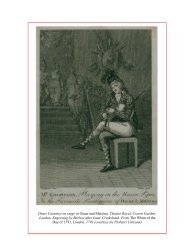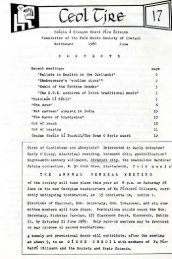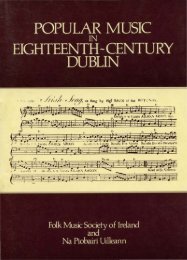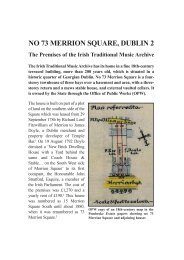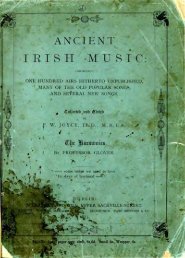Download - Irish Traditional Music Archive
Download - Irish Traditional Music Archive
Download - Irish Traditional Music Archive
Create successful ePaper yourself
Turn your PDF publications into a flip-book with our unique Google optimized e-Paper software.
THE UILLEANN PIPES IN IRISH TRADmONAL MUSIC<br />
Uilleann pipes, also known as union pipes or <strong>Irish</strong> pipes, are the specifically<br />
<strong>Irish</strong> form of bellows-blown or elbow-blown bagpipes.<br />
The term 'uilleann pipes' is pronounced 'ill-un pipes' with the stress on<br />
the first syllable. Deriving from the <strong>Irish</strong> uille/uillinn 'elbow' and variously<br />
spelt, it is a modern coinage introduced only at the turn of this century, but<br />
now universally used. The older terms, 'union (bag) pipes' and '<strong>Irish</strong> (bag)<br />
pipes', have been in use since the eighteenth century. The modern name<br />
has been translated into <strong>Irish</strong> as pib uilleann and the instrument is also<br />
referred to in <strong>Irish</strong> by the older piopai, a generic term for pipes.<br />
Bagpipes in General<br />
Bagpipes, classified as wind instruments and reed instruments, essentially<br />
consist of a reeded chanter or melody-pipe, with finger-holes, which is<br />
sounded with air from an attached bag held under the player's arm. In the<br />
older form the bag is inflated through a blowpipe h eld in the mouth.<br />
Almost all bagpipes also have reeded pipes of fixed pitch called drones<br />
which sound continuously with the chanter melody. Bagpipe reeds, made of<br />
cane or other materials, are fixed in the various pipes of the instrument and<br />
produce sound as they vibrate under air pressure. They can be single reeds<br />
(one piece of the material) or double (two pieces bound together). Mouthblown<br />
bagpipes are thought to have originated in the prehistoric period in<br />
the Near or Middle East from which they have spread throughout Europe,<br />
to India and to North Africa. In recent times the Scottish Highland form<br />
has spread throughout the world.<br />
A bellows attached to the player's elbow has been used in Europe for<br />
inflating the bag since at least the sixteenth century, and bellows-blown<br />
forms include the Czech dudy, the French musette, the English Northumbrian<br />
small-pipes and the Scottish Lowland pipes.<br />
The <strong>Irish</strong> Uilleann Pipes<br />
Uilleann pipes differ uniquely from other bellows-blown bagpipes in having<br />
a main chanter range of two octaves and a number of closed chanters called<br />
regulators which can be used in combination for harmonic and rhythmic<br />
accompaniment, and they are almost unique in having the main chanter<br />
closed for almost its entire range, a feature which allows a silence between<br />
notes.
All parts of the instrument, including the reeds, are custom-made, and<br />
the materials now used in its construction are close-grained woods such as<br />
ebony and boxwood for chanter, drones, regulators, etc.; animal skin,<br />
rubber or plastic for the bag, connectors and valves; brass or silver for metal<br />
fittings; and plastic (formerly ivory) for decorative or supporting<br />
components.<br />
A full modern set of uilleann pipes (see drawing) consists of<br />
• an open-ended fixed-pitch wooden chanter of conical bore, fitted<br />
with a double reed, with seven finger-holes in its front and one<br />
thumb-hole in its back. Its diatonic scale is produced by crossfingering.<br />
The bottom note of the chanter is conventionally called D,<br />
whatever its actual pitch. The commonest chanter, a 'concert pitch'<br />
chanter, is 36 cm in length and has as bottom note the D above<br />
middle C. 'Flat sets' are pipes with bottom chanter notes lower than<br />
D: from C sharp to B flat. Bottom chanter notes higher than Dare<br />
sometimes found: E flat or E.<br />
Different numbers of metal keys can be fitted to chanters to<br />
provide chromatic semi tones, but the only one required by the music<br />
normally played on the instrument is that which produces C natural<br />
in the second octave.<br />
Except for the production of its bottom note, the chanter is<br />
normally closed off at its end by being rested on a piece of leather<br />
called the popping strap tied on the knee of the player. This sealing<br />
of the chanter is necessary for the playing of the higher octave which<br />
is partly achieved by 'overblowing' or the exerting of extra pressure<br />
by the elbow on the bag, and it allows an instant of silence to occur<br />
between notes.<br />
• the bag, which is fed with air from the bellows and, which supplies air<br />
to the sounding parts.<br />
• the main stock, a hollow wooden cylinder onto or into which are<br />
fixed the bag, drones and regulators, and which is fed with air from<br />
the bag.<br />
• the three wooden drones, pipes of cylindrical bore, which sound<br />
continuously and are fitted with single reeds: the small or tenor
l. Bag 6. Bass drone<br />
2. Bellows 7. Tenor regulator<br />
3. Main stock 8. Baritone regulator<br />
4. Tenor drone 9. Bass regulator<br />
5. Baritone drone 10. Chanter<br />
After Wilbert Garvin, THE IRISH BAGPIPES: THEIR CONSTRUCTION AND MAINTENANCE<br />
2nd ed., Ballyrnena, 1988, p. 3
drone (tuned in unison with the bottom note of the chanter), the<br />
middle or baritone drone (an octave below the tenor), the big or<br />
bass drone (an octave below the baritone). The drones may be<br />
silenced by the use of a switch on the main stock.<br />
• the three wooden regulators, tenor, baritone and bass, which are<br />
closed fixed-pitch chanters of conical bore fitted with double reeds<br />
and four or five metal keys each of which sounds a note when<br />
pressed. The regulators lie beside each other so as to allow the<br />
playing of simple tonic or dominant chords, or individual notes,<br />
when the keys are activated by the heel of the lower hand or the<br />
fingers of a temporarily free hand. The regulators are only<br />
sometimes used.<br />
The uilleann pipes are a relatively quiet indoor instrument, almost<br />
always played in a sitting position with the bag under one arm and the<br />
bellows under the other; with the left hand, usually, covering the thumbhole<br />
and upper three finger-holes and the right the remaining holes; and<br />
with the drones and regulators lying across the thigh of the player. They<br />
are played by professionals and amateurs, of all social classes, and most<br />
players have been men. They are not very widely played in comparison<br />
with the fiddle and other instruments, probably because they are<br />
relatively expensive to acquire and difficult to play, tune and maintain,<br />
but they have a high status and are played solo more than other<br />
instruments. Learners can begin with bag, bellows and chanter, and add<br />
drones and regulators by degrees. Most music performed on the pipes is<br />
dance music, but played more nowadays for recreational listening than<br />
for dancing, and most pipers also have a repertory of 'slow airs', song airs<br />
played instrumentally.<br />
Style<br />
There are now no regional piping styles, and pipers develop their own<br />
personal styles or imitate the styles of virtuoso players. The melody may be<br />
played with a lesser or greater degree of articulation. The former style,<br />
'open', 'loose', or legato playing, uses the minimum number of fingers<br />
needed to produce a note, while the latter style, 'tight' or non-legato<br />
playing, uses the maximum. Most players use a mixture of the two styles.<br />
The normal melodic ornaments of <strong>Irish</strong> traditional music - grace notes,<br />
rolls and triplets etc. - are used on the pipes, and in addition special<br />
ornaments such as crans, tight triplets, popping, etc. Style also includes<br />
the uses to which the drones and regulators are put.
History<br />
The uilleann pipes are thought to have developed in Ireland in the early<br />
eighteenth century, possibly in the southern half of the country and<br />
probably under the influence of foreign forms, and they gradually replaced<br />
the earlier mouth-blown bagpipes played here since medieval times. The<br />
oboe and German flute, introduced to Ireland in the decades around 1700,<br />
may have had an influence on their development. The instrument was<br />
being referred to as the '<strong>Irish</strong> pipes' by the early 1770s, suggesting that a<br />
distinctly national form had evolved by the mid-eighteenth century, and by<br />
the 1790s it was being called the 'union pipes', seemingly in reference to<br />
the addition of a regulator in the previous decade, or to the union of<br />
drones and regulator in the main stock. It reached its developed form in the<br />
early nineteenth century, when it replaced the harp as the classical<br />
instrument of <strong>Irish</strong> music, and by the mid-century it was being widely played<br />
throughout the country (less widely in the northern counties where the<br />
fiddle was dominant) and even in Britain and the United States.<br />
The social consequences of the Great Famine of the 1840s and the<br />
introduction of mass-produced concertinas and melodeons from Britain<br />
and Germany in the second half of the century almost brought the<br />
instrument to extinction, but it was boosted by the Gaelic Revival movement<br />
of the 1890s and early twentieth century, and clubs were founded in Cork<br />
and Dublin for its promotion. Its fortunes waned again from the War of<br />
Independence until the r'evival of interest in <strong>Irish</strong> traditional music which<br />
began in the 1950s and which still continues. There are now hundreds of<br />
good pipers in Ireland and abroad, and the uilleann pipes are at their<br />
strongest since before the Famine. Detailed studies of piping have been<br />
made, makers of pipes are unable to keep up with demand, and the<br />
instrument is being used in the playing of music other than traditional<br />
music. A specialist international society exists for the promotion of the<br />
pipes: Na Piobairi Uilleann (the Society of Uilleann Pipers), 15 Henrietta<br />
Street, Dublin 1 (tel. 01-730093).<br />
For further details, see 'The Uilleann Pipes: A Listening and Reading List',<br />
available from the <strong>Archive</strong> for a SAE or International Reply Coupon.<br />
© <strong>Irish</strong> <strong>Traditional</strong> <strong>Music</strong> <strong>Archive</strong> / Taisce Cheal Duchais Eireann, 1992.<br />
No 5 of a series of information leaflets.<br />
Available from the <strong>Archive</strong> at 63 Merrion Square, Dublin 2<br />
(tel. 01-619699, fax 01-686260).<br />
Grant-aided by An Chomhairle Ealaion / The Arts Council and the<br />
Arts Council of Northem Ireland.



